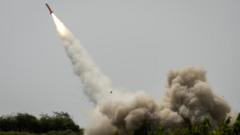The US Space Force, based at Buckley Air Force Base in Colorado, operates 24/7 to track missile launches globally through advanced satellite technology. With growing threats from nations like China and Russia, this military branch is at the forefront of U.S. defense, revealing its strategies and operations designed to maintain space superiority.**
Inside the Command Center: The US Space Force's Global Missile Tracking Operations**

Inside the Command Center: The US Space Force's Global Missile Tracking Operations**
A rare glimpse into the US Space Force's Buckley Base highlights its key role in monitoring missile launches worldwide and future defense strategies.**
The command room at Buckley Space Force Base in Colorado is a high-alert nerve center where U.S. military personnel, known as Guardians, monitor global missile activity around the clock. In a recent exercise, reporters were permitted to observe this critical operation that combines state-of-the-art technology with urgent military strategy.
Inside the facility, Guardians react instantly to simulated missile launch commands, showcasing their role as the first responders to such events. With giant screens displaying data from a network of military satellites, the team is equipped to track missile launches from inception to their projected impact zone. This robust capability was put to the test during a legitimate threat from Iran, allowing them to inform ground forces and protect U.S. personnel stationed abroad.
Colonel Ann Hughes, overseeing operations at Buckley, noted the intensity of the situation, particularly during significant events like Iran's missile response to perceived provocation from U.S. and allied forces. The U.S. Space Force has steadily increased its operational tempo as global conflicts challenge its capacity for defensive and strategic overlays.
A key part of U.S. defense strategy is the ambitious "Golden Dome," an extensive missile defense project initiated to protect against advanced threats from adversaries such as China and Russia. Lieutenant General David Miller explained that these nations have progressed in missile technology, including hypersonic weapons that pose new challenges for detection and interception.
The discussions at Buckley underscore a paradigm shift in military operations—moving toward achieving superiority in space, an arena that is increasingly contested. As Guardian Colonel Phoenix Hauser noted, the U.S. Space Force’s vigilance towards adversarial maneuvers in space, including electronic jamming and potential anti-satellite actions, highlights the necessity for readiness in an evolving battlefield.
As space becomes more congested with approximately 12,000 satellites currently in orbit and projections suggesting a growth to 60,000 by the decade's end, the competing interests of nations intensify. The U.S. Space Force is adapting by developing capabilities for both offensive and defensive operations to maintain a strategic advantage.
The ongoing tension in international relations has led to military operations being increasingly reliant on space-based assets. Recent U.S. strikes against Iranian targets reaffirm the importance of these capabilities, as U.S. military operations leverage the advantages gained through space technologies for precision strikes and operational success.
In summary, the U.S. Space Force continues its evolution as a crucial component of America's military strategy, with a commitment to remain at the forefront of endeavors that ensure national security in both terrestrial and extraterrestrial realms.



















